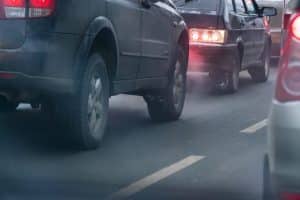What Does “Safe Following Distance” Mean Under the Law?
 Tailgating is dangerous. When drivers follow too closely, they increase the likelihood of accidents, especially during sudden traffic speed changes and lane maneuvers. For this reason, the Commonwealth of Massachusetts has rules about what constitutes a “safe following distance” for vehicles.
Tailgating is dangerous. When drivers follow too closely, they increase the likelihood of accidents, especially during sudden traffic speed changes and lane maneuvers. For this reason, the Commonwealth of Massachusetts has rules about what constitutes a “safe following distance” for vehicles.
Under 720 Mass. Reg. 9.06, “The driver of a vehicle shall not follow another vehicle more closely than is reasonable and prudent, having due regard to the speed of such vehicle and the traffic upon and condition of the highway.”
What makes for a “reasonable and prudent” following distance?
A “reasonable and prudent” following distance allows enough space between your car and the vehicle in front of you to allow you to safely maneuver and brake in response to traffic in front of you. This minimizes the risk of rear-end collisions. The National Safety Council (NSC) refers to this as the "three-second plus rule.” According to the rule, when the leading vehicle passes a fixed point, like a mile-marker sign, count three seconds before reaching the same spot. If you arrive sooner, you are likely following too closely and should slow your speed accordingly.
However, in the following circumstances, “prudent” following distance increases beyond three seconds:
- Poor weather conditions: Reduced visibility and slippery roads demand greater distance to safely react to potential hazards.
- Highway entrance ramps: Merging and allowing others to merge with traffic flow requires extra caution around highway entrance ramps, with a longer following distance better ensuring safe highway transitions.
- Traveling around curves: Curvy roads are generally low-visibility roads, and you are safer if there’s a little extra space between you and the other drivers.
- Traveling on older tires: If you need new tires or if the treads are starting to show signs of significant wear, increase your following distance.
- Following large vehicles: Maintaining additional space behind trucks and buses is important because these large vehicles have larger blind spots. If you are following one, try to be within the visible range of the driver. Note: if you are towing a trailer or driving a larger truck (like a moving truck), you should keep a greater distance between you as well.
The NSC recommends adding at last one second – there’s the “plus” in the rule – for every “poor” condition you’re experiencing, such as bad weather, driver fatigue, or inexperience. New drivers, the NSC says, should assume a baseline of four seconds, whereas elderly drivers may need as much as six seconds, depending on their reflexes and visual acuity. The organization also recommends that commercial truck drivers maintain a distance of seven to 12 seconds.
Following too closely or tailgating?
Tailgating is following a car too closely. This unsafe driving behavior is also a primary cause of numerous fatal accidents among teen drivers. According to Boston 25 News, in 2022, 49 drivers aged 16 to 19 lost their lives in crashes, marking the highest toll since 2008.
What are common causes of unsafe following distances on the road?
Unsafe following distance can stem from various driver behaviors and circumstances. Some common causes include:
- Reckless driving: Drivers who exhibit reckless behavior, such as aggressive acceleration, sudden braking, or weaving between lanes, often fail to maintain a safe following distance.
- Distracted driving: Distractions like texting, talking on the phone, adjusting the radio, or engaging with passengers divert a driver's attention from the road ahead. Consequently, they may fail to recognize changes in traffic patterns or the need to adjust their following distance accordingly.
- Drugged/drunk driving: Impaired drivers under the influence of drugs or alcohol have compromised judgment, slowed reaction times, and reduced coordination, impairments that make it difficult to accurately assess their following distance and respond promptly to changing road conditions.
- Road rage: Road rage is different from aggressive driving, in that folks who experience it may engage in actively aggressive, dangerous behaviors not out of negligence, but out of a desire to cause harm.
What should you do if you’re being tailgated by another driver?
If another driver is following too closely, do not “brake check” them. We know the urge can be strong, but it’s dangerous; furthermore, it could open you to liability for a crash. Do not speed up just to put space between you and the car behind you; this can actually encourage the tailgater to speed up as well, and now you’ll be in a more precarious position.
Instead, maintain your current speed and distance between you and the car in front of you. If safe to do so, move into another lane and allow the tailgater to pass you by. If the vehicle follows you into the next lane and continues to tailgate, we recommend exiting the road you are on and driving to a police station, hospital, or firehouse – whatever is closest. A truly distracted driver may not have noticed they are tailgating you, and an aggressive driver may think twice about following you into one of these places. A driver experiencing road rage, however, may not care, and you’ll want to be somewhere safe in the event he or she attempts to move from aggressive driving to aggravated assault.
Contact our Boston legal team today
If an aggressive, tailgating driver hurts you or your loved one, Breakstone, White & Gluck is here to help. Our Boston car accident lawyers have secured millions of dollars on behalf of clients who were harmed by the negligence of others. To help keep our streets safe, we hold dangerous drivers accountable. Call or contact us today for a free consultation, and let us help you piece your life back together during this challenging time. Proudly serving all of Massachusetts.
